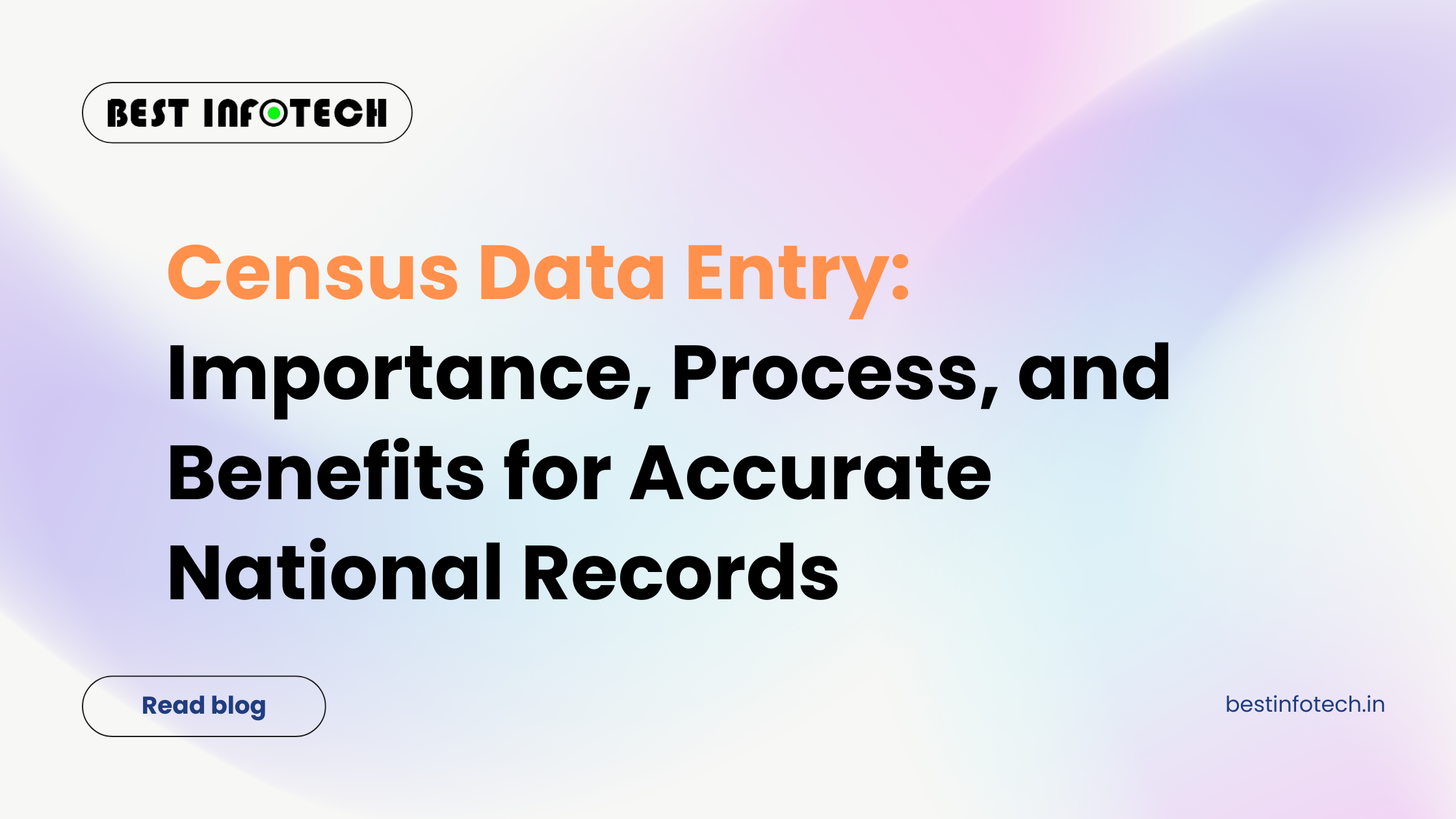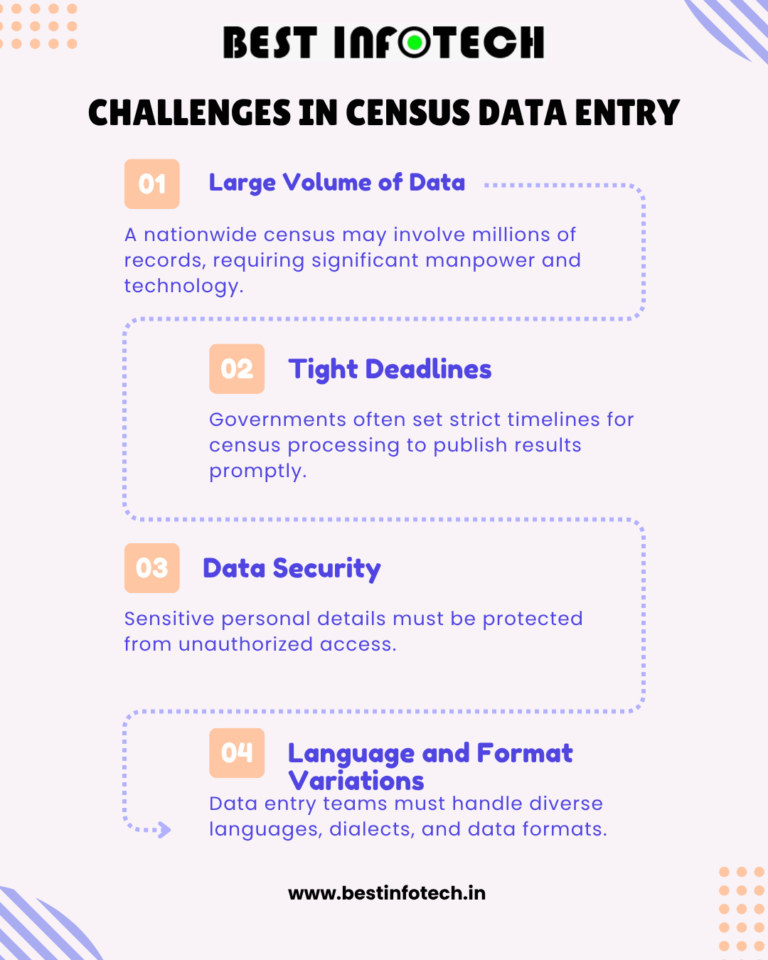Census Data Entry: Importance, Process, and Benefits for Accurate National Records
 August 9, 2025
August 9, 2025 
Data-driven governance and planning rely on accurate information. Census data entry plays a crucial role in ensuring that population statistics, demographic information, and socio-economic data are recorded, stored, and analyzed correctly. Governments, researchers, and organizations depend on this data to make informed decisions about infrastructure, education, healthcare, and other critical services.
Whether you are a government agency, NGO, or research institution, understanding the importance of census data entry can help you ensure the accuracy and efficiency of your data management process.
What is Census Data Entry?
Census data entry is the process of converting collected census information—usually from surveys or fieldwork—into a structured digital format. This data includes:
Population count
Age, gender, and marital status
Employment and education details
Household information
Migration and housing statistics
Once digitized, this information becomes a valuable asset for analysis, reporting, and policy formulation.
Why is Census Data Entry Important?
The success of a census doesn’t end with data collection—it depends on accurate entry and processing. Here’s why it matters:
1. Accurate Decision-Making
Governments rely on census data to decide where to allocate budgets, build infrastructure, or improve social services. If data entry is flawed, policies could be based on incorrect information.
2. Efficient Resource Allocation
Proper census data entry ensures resources—such as hospitals, schools, and roads—are distributed according to actual population needs.
3. Long-Term Planning
Urban development, housing projects, and public transport planning all depend on long-term projections derived from census data.
4. Historical Records
Census data becomes part of national archives, providing valuable historical insights for future generations.
The Process of Census Data Entry
A well-organized census data entry process can help prevent errors and ensure faster results. Below is the typical workflow:
Step 1: Data Collection
Census takers gather information via paper forms, mobile apps, or online surveys.
Step 2: Data Preparation
Collected forms are sorted, verified, and prepared for entry.
Step 3: Data Entry
Trained professionals enter the data into secure software systems. This may be done manually or through automated scanning and recognition technology.
Step 4: Data Cleaning
After entry, data is checked for errors, duplicates, or missing information.
Step 5: Data Validation
Cross-checking ensures the data matches original forms and follows predefined rules.
Step 6: Data Storage and Security
Finalized census data is stored securely for further analysis and reporting.
Manual vs. Automated Census Data Entry
Both manual and automated methods have their advantages and limitations.
| Method | Advantages | Limitations |
|---|---|---|
| Manual Data Entry | High accuracy for complex forms; allows human judgment | Time-consuming; prone to human error |
| Automated Data Entry | Faster processing; ideal for large volumes | Requires setup of scanning systems; may misread unclear text |
In many cases, a hybrid approach—combining automation with manual verification—delivers the best results.

Challenges in Census Data Entry
Census data entry is a large-scale operation, and it comes with several challenges:
1. Large Volume of Data
A nationwide census may involve millions of records, requiring significant manpower and technology.
2. Tight Deadlines
Governments often set strict timelines for census processing to publish results promptly.
3. Data Security
Sensitive personal details must be protected from unauthorized access.
4. Language and Format Variations
Data entry teams must handle diverse languages, dialects, and data formats.
Best Practices for Accurate Census Data Entry
To ensure high-quality results, organizations should follow these best practices:
1. Hire Trained Data Entry Professionals
Skilled operators reduce errors and speed up the process.
2. Use Reliable Data Entry Software
Modern tools can flag inconsistencies, detect duplicates, and validate formats automatically.
3. Implement Quality Control Checks
Multiple review stages help catch errors before finalizing data.
4. Ensure Data Security
Use encryption, secure servers, and access control to protect sensitive information.
5. Standardize Data Formats
Consistent formats make data easier to process and analyze.
Outsourcing Census Data Entry Services
Many governments and organizations choose to outsource census data entry to specialized service providers. Here’s why outsourcing can be beneficial:
Expertise – Professional firms have trained teams with experience in large-scale data projects.
Faster Turnaround – Dedicated resources can complete data entry within tight deadlines.
Cost-Effective – Outsourcing eliminates the need for in-house infrastructure and staffing.
Scalability – Service providers can quickly scale operations during peak workloads.
How Best Infotech Can Help
At Best Infotech, we specialize in accurate, efficient, and secure census data entry services. Our team is trained to handle large-scale projects with precision, ensuring:
High accuracy rates
Confidential handling of sensitive data
Advanced tools for faster processing
Quality checks at every stage
We work with government agencies, NGOs, and research institutions to deliver timely and reliable census data entry results.
Final Thoughts
Census data is the backbone of national planning, and accurate census data entry ensures this information remains reliable for years to come. By using expert data entry services, organizations can speed up processing, maintain accuracy, and safeguard sensitive records.
If you are looking for a trusted partner to handle your census data entry needs, Best Infotech offers a complete solution tailored to your requirements.
Contact Us Today
Ensure your census data is processed with accuracy, security, and speed.
Click here to get in touch with Best Infotech and discuss your data entry needs with our experts.
